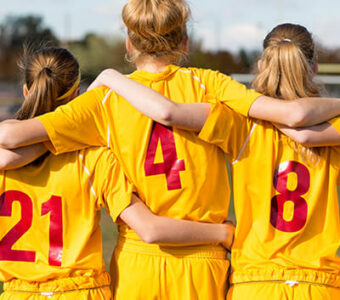Parents of young athletes are becoming increasingly aware of the dangers of concussions. But how much of what you think you know about concussions is correct? We asked OhioHealth athletic trainer and concussion testing coordinator Casie Elander a bunch of questions about how to spot, test for and avoid concussions in children and young athletes. Here’s what she had to say.
What is a concussion?
“A concussion is a traumatic brain injury, but many people think it’s a bruising or a bleeding of the brain. Those are different types of injury,” says Elander. “I describe a concussion as chemical chaos within your brain’s cells that can produce different symptoms based on the severity of the chaos.”
How do young people get concussions?
Elander says the classic concussion scenario is a direct blow to the head, and that can happen through player-to-player contact or by hitting the ground or floor. “But head impacts aren’t the only cause. A rapid twist or swivel of the head can cause a concussion, like whiplash for example. Even landing hard on your bottom can send a jolt through your body that impacts the brain. Concussions often result from unexpected hits or quick movements athletes were unprepared for.”
What are the on-the-field symptoms of concussions?
“No two concussions are really the same – we joke that if you’ve seen one concussion, you’ve seen one,” says Elander. But she says some classic symptoms are headache – more so brain pain than skull pain from the blow – dizziness, sensitivity to light, confusion, and a distant, glassy look to the eyes. Elander adds that coaches and parents should be on the lookout for unusual behavior and that symptoms can sometimes take 30 minutes, or even a day, to appear.
What on-the-sideline tests are used to assess the likelihood of concussion?
“If we suspect a concussion, we perform a cranial nerve test with the athlete, check the movement of their hands and face, their smile and bite, test their balance and ask them questions to check cognition,” says Elander. “We are assessing brain function, cranial nerve function, and gross and fine motor function.”
Should athletes come out of the game completely if a concussion is suspected?
“Not only should they come out for their own safety, Ohio law requires it,” says Elander. If a concussion is suspected, youth athletes must be removed from play. They cannot return to play or practice the same day, and must be cleared by a physician or another authorized medical professional in writing before they can return to practice or competition. Details on the law and the responsibilities of coaches, referees, parents and players are available on the Ohio Department of Health website.
What are the next steps? What type of care provider should I see, and what will they do?
Elander suggests that young athletes see a primary care sports medicine physician or their family doctor, who will perform a complete physical exam and any necessary neurocognitive testing. After that? “At OhioHealth, we believe that the safest return to play is a gradual, functional return to play. It used to be that athletes would stay out for a week, then jump right back into full activity. Today, we advocate for the use of a five-stage guided return-to-play protocol.” Elander says they slowly increase an athlete’s level of activity over the course of several days to see if concussion symptoms reappear. “If an athlete returns to play without being fully healed, they are at increased risk of Second Impact Syndrome, which can cause, in almost all cases, permanent brain damage, and in some cases even death.”
How do you recover from a concussion?
“Rest. The brain needs to rest. And not just physical rest, but cognitive rest, too,” says Elander. “Take a break from mental stimulation. Reduce screen time, reduce earbud time, relax in an environment that’s not too bright, not too loud. In some cases, we’ve even limited an athlete’s school day, or what is expected of them at school.
What are the lasting effects of concussion? Do you completely recover? Is there a lifetime limit you should stay below?
Elander says, “People should understand that there’s no such thing as a mild concussion, like ‘getting your bell rung’ – a concussion is a traumatic brain injury. And kids take longer to recover from concussion, but they can make a complete recovery. We just need to give them, and they need to give themselves, time to heal. Having a concussion makes future ones easier to get, but there’s no predetermined healthy limit or safe threshold. It’s more about looking at a person’s collective history of injury. But the more concussions you have, the greater the likelihood of sustaining long-term injury, and in some cases may lead to medical disqualification from sports.”
Are there good ways to prevent concussions in sports?
“Though helmets certainly reduce the likelihood of injury to your face and head, we don’t know that helmets reduce concussions,” says Elander. “The best way to attempt to prevent concussion is education and proper coaching techniques for athletes, especially in sports like football, soccer and lacrosse.”
Elander also recommends working on neck strength, wearing properly fitted mouth guards and practicing proper tackling and hitting techniques in contact sports. All of these practices have the potential to reduce the chance of concussion.
OhioHealth has sports medicine experts throughout central Ohio ready to provide care to athletes and active people of any age with sports- and activity-related injuries, including concussions. Call our Sports Medicine Hotline at 614-566-GAME (4263).





